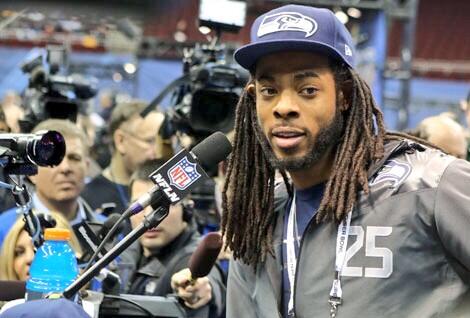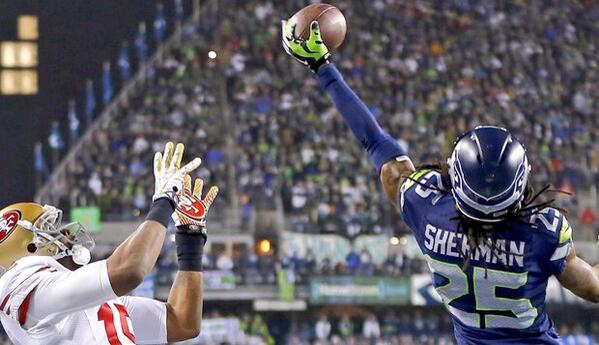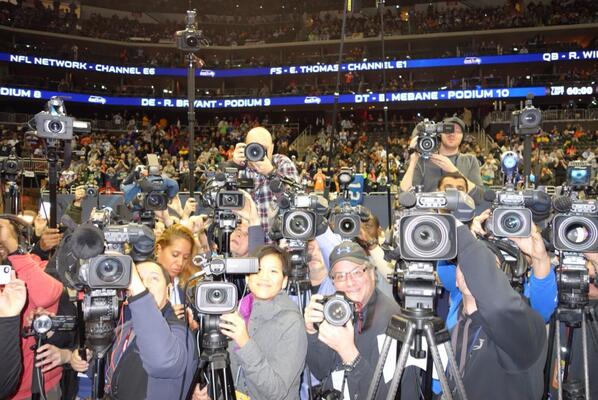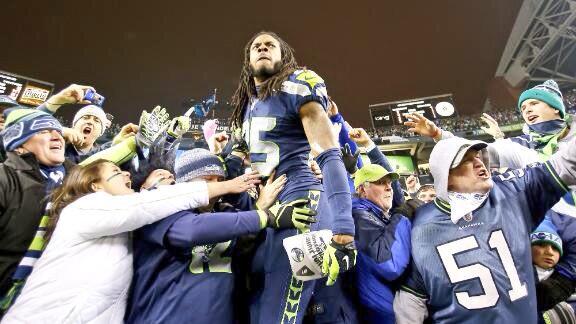The Manipulation Of A Mass-Reaction: A Richard Sherman Analysis


It was a public relations masterpiece.
Moments after breaking up a pass and clinching his team’s berth in the Super Bowl, Sherman was approached by Fox reporter Erin Andrews for a postgame interview. The purpose of these interviews, from the perspective of a journalist, is to capture an interesting sound bite that can become the basis of further content, effectively creating news. Most athletes conduct these interviews relying upon sports clichés – “it was a team effort”, etc. – because they do not want to become the focus of the news, for a variety of reasons. Thankfully for journalists, however, Richard Sherman isn’t like most athletes.
Whether or not Sherman intended to spark a national conversation and enter the cultural zeitgeist when Andrews put a microphone in his face is impossible to know. What matters is that after his 20 seconds of screaming on live TV, society’s mass-reaction through social media and mass media made him one of the most-talked about athletes in the nation.
Sherman’s public relations began with the interview itself, as the first step of the PR mechanism he utilized is to capture the attention of a large audience through the frame of a cultural event. An effective way to capture an audience’s attention is, naturally, to subvert their expectations. So, instead of unloading the typical unselfish refrain that his audience was expecting, Sherman ignored Andrews’ question and launched into pure wrestling-style, self-promotion trash talking: “I’m the best corner in the game, when you try me with a sorry receiver like Crabtree, that’s what you’re going to get.” He connected with the audience in a very deliberate and conscious manner, looking directly into the camera and allowing the adrenaline of the moment to flow through him as he yelled and proclaimed his athletic dominance. But, unlike countless similar sports rants, he never cursed. He came across to many as rude and unsportsmanlike, but for 20 seconds, Sherman captured their attention, effectively advertising himself to the world. Here I am society – feast yourselves upon me.
Social media and mass media both gorged on Richard Sherman. The mass-reaction to the interview represents the second step of the PR mechanism: proliferation. The instantaneous Twitter reaction was an essential component of Sherman’s utilization of the mechanism, as it was the first indicator that the live TV event was effective in capturing the audience’s attention. The magnitude of the social media reaction validated mass media’s desire to turn Sherman’s statements into a huge, controversial story. Immediately following the interview, Sherman gained more than 300,000 Twitter followers. More than a million Twitter users mentioned Sherman that night, and many more expressed their feelings on Facebook.
The social media response was largely negative, with thousands of individuals using the words “classless” and “disrespectful,” the worst of whom followed those up with “thug,” “monkey,” and the n-word. Mass media was equally eager to criticize Sherman. In fact, on the day following the game, the word “thug” was said on national television more times than any day in the past three years. It even beat out August 29, 2013 – the day in which John Kerry called Syrian President Bashar al-Assad a “thug.” The initial mass-reaction to Sherman’s statements was full of vitriol, but Sherman’s ability to subsequently control the direction of the conversation following the mass-reaction enabled him to turn his infamy into marketability.
The third and final aspect of Sherman’s public relations was his spin of the conversation by manipulating social media and mass media. In order to turn his infamy into marketability, Sherman manipulated both forms of media into having a particular conversation, which would quickly lead to a radical change in his public perception. Sherman's first move was to rally support on social media. Before conducting any further interviews, he encouraged his followers online to advocate for him, to dispute those who would paint him as a “thug.” He posted pictures of himself with his mother, along with a heartfelt letter from a young fan. He also held a Super Bowl ticket giveaway through his website and Twitter.
He utilized a similar strategy in his interactions with mass media in the days following the interview. His first public statements were apologetic and thoughtful, an extension of his efforts on social media to dispute those describing him as a “thug.” But before long, he steered the mass media conversation in a completely different direction. He shifted the conversation from his own actions to society’s at large, calling into question the coded racism of the mass-reaction itself. Sherman’s statements regarding the “thug” narrative – “it seems like it’s an accepted way of calling someone the N-word nowadays” – quickly overshadowed his lack of sportsmanship and became the main talking point of the mass media conversation. Instead of questioning whether Sherman was a “thug,” society was now questioning itself for ever considering the possibility. He completely flipped the narrative in a nuanced way that demonstrated his Stanford education.
At this point in the saga, it’s important to bring up Sherman’s backstory – which you are likely already aware of. Sherman is from Compton. The connotations associated with growing up in Compton are so strong they don’t really need to be mentioned. But not only did Sherman transcend that, he graduated high school near the top of his class, with a 4.2 GPA, and gained a scholarship to go to Stanford, play football, and study communications.
He is the antithesis of everything a “thug” is supposed to be. But of course, he is black (and also has dreadlocks), so by yelling aggressively into the camera on live TV (while looming over a pretty blonde reporter lady), a “thug” narrative was sure to ensue. And Sherman was entirely prepared for it. In fact, on the very day of his now-famous postgame rant, Beats by Dre headphones released a strangely prophetic commercial featuring Sherman. He is in a locker room giving a fictional interview, and reporters ask repeated questions with increasing levels of gang-related implications surrounding his childhood in Compton. The scene comes to a climax when one reporter asks, “How do you feel about your reputation as a thug?” and Sherman places on his overpriced headphones to zone out the reporters. It’s uncanny, really.


Sherman’s ability to maximize his time in the spotlight is worth discussing because of what it represents. NFL players typically have a difficult time gaining endorsements – relative to athletes in other professional sports, at least – because they are usually wearing helmets. The obstruction of their faces limits their opportunity to be easily recognized, therefore limiting their marketability. Defensive players, in particular, almost never rise to the level of fame Sherman has achieved. His efforts have illuminated the mechanism in place for public relations to impact society’s mass-reaction to cultural events. By illuminating this mechanism and demonstrating the potential resulting gains, Sherman has set a blueprint for entertainers of any field to manipulate social media conversation and mass media coverage in order to increase their own marketability.
The instantaneous social media mass-reaction to cultural events, such as Sherman’s live interview, is a relatively new phenomenon with massive untapped economic potential. Examples of athletes and other entertainers using public relations to manipulate the ensuing conversations are likely to become increasingly popular as our society seeks new cultural events to gorge on.
Today’s society has an insatiable appetite, and Richard Sherman has capitalized – one PR spoonful at a time.
Reach Staff Writer Ryan Bouizane here.



